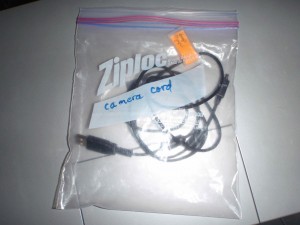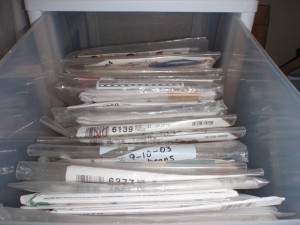What do camera cords, sewing patterns, and puzzle pieces all have in common? They are items that are hard to store in a neat, accessible manner. Somewhere along the way, it occurred to me to use zip top (ziplock) plastic bags for these and other hard to organize, but useful things.
Charger cords and connector cables: Instead of having a drawer of tangled phone charger cords and camera computer cables, I now have each cord labeled with a colorful bit of paper (whose and what equipment, i.e. Greg’s Olympus). A layer of transparent tape holds it in place and provides durability of the label. Then, each cord is given its own plastic bag. Size of bag depends on size of cord and how much uniformity of bag size makes you happy. It is also handy to label the plastic bags. This helps avoid it getting thrown away as just something laying around when the cord is in use; plus, if you see it, you know you forgot to put away a device cord that might be easily lost.
Sewing patterns: Once a sewing pattern has been opened, it is notoriously difficult to get back in the paper envelope. It is much easier and less destructive to the pattern pieces to fold them fewer times and put them in a once used, washed and dried, gallon plastic bag, with the envelope also inside, but on top for identification. When I do it, it still only fills about half the bag, so the top folds over. This means I can use the old bags, with non-working zip tops.
Fabric that is cut out for sewing: Another variation on this is using clear plastic bags for holding together and storing sewing projects that you have cut out, but won’t sew yet. Sometimes I just feel like cutting out several things. 🙂 The bagged pieces sit nicely in a bin until later.
Packing for travel: With (s0-called?) security personnel rifling through under garments and the challenges of living out of a suitcase for even a few days, sectional packing in zip top plastic bags can save much frustration. I can’t say how it affects search and mangle protocol, but my things have always come through neatly since I began packing this way. As for me needing to look through my suitcase while getting ready for whatever particular travel excursion, I can move a whole plastic bag of socks or belts quickly, see what is in it, and put it back as neatly as I found it in a matter of seconds. Who wants to waste time rummaging through or reorganizing the suitcase??
Puzzles: From large piece toddler floor puzzles to 1000 piece family projects, puzzle boxes don’t last that long and puzzle pieces slip into the unknown. We have lessened our losses by finding a simple code to put on the back of each piece when the puzzle is originally opened. Even if we want to use the box for now, the pieces are put in a zip top plastic bag in the box. When the box wears out or is inconvenient for storage space, the picture top can be cut off and placed in the plastic bag. If it is too large, it can be stored in the same bin as the bags of puzzles, but don’t forget to also put the code on it. We even use a bag for pieces that cannot be immediately given the correct home.
Transporting documents: The comparatively strong plastic of zip top plastic bags makes these bags good for carrying documents for the short term. When we travel, I use a plastic bag for the itinerary and any other things like extra birth certificates or boarding passes that might be needed. The papers stay cleaner and easier to read. The plastic even slips in and out of the luggage pocket more quickly and smoothly than just paper.
Screws and small furniture pieces: It is easy to lose important small parts, like screws or shelf holders when moving furniture. If these are placed in a zip top plastic bag and taped to the object they belong to, it doesn’t matter how many times you change your mind about where you want it or how long it is stored in the garage in between. The pieces will be there waiting for you and you will breath a sigh of relief.
Surely there are many other useful ways to recycle plastic bags, particularly the zip top ones. I’d love to hear about them.


